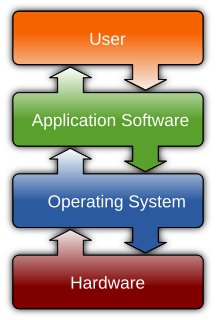Speech synthesis is the artificial production of human speech. A computer system used for this purpose is called a speech computer or speech synthesizer, and can be implemented in software or hardware products. A text-to-speech (TTS) system converts normal language text into speech; other systems render symbolic linguistic representations like phonetic transcriptions into speech.
A universal translator is a device common to many science fiction works, especially on television. First described in Murray Leinster's 1945 novella "First Contact", the translator's purpose is to offer an instant translation of any language. Technology companies are striving to develop a practical "universal" translator for common use.

SRI International (SRI) is an American nonprofit scientific research institute and organization headquartered in Menlo Park, California. The trustees of Stanford University established SRI in 1946 as a center of innovation to support economic development in the region.
Nuance is a U.S. based multinational computer software technology corporation, headquartered in Burlington, Massachusetts, United States on the outskirts of Boston, that provides speech recognition, and artificial intelligence. Current business products focus on server and embedded speech recognition, telephone call steering systems, automated telephone directory services, and medical transcription software and systems. The company also maintains a small division which does software and system development for military and government agencies based in Westborough, Massachusetts, allegedly called Twined.

A dialogue system, or conversational agent (CA), is a computer system intended to converse with a human with a coherent structure. Dialogue systems have employed text, speech, graphics, haptics, gestures, and other modes for communication on both the input and output channel.

Google Translate is a free multilingual machine translation service developed by Google, to translate text. It offers a website interface, mobile apps for Android and iOS, and an API that helps developers build browser extensions and software applications. Google Translate supports over 100 languages at various levels and as of May 2017, serves over 500 million people daily.
Statistical machine translation (SMT) is a machine translation paradigm where translations are generated on the basis of statistical models whose parameters are derived from the analysis of bilingual text corpora. The statistical approach contrasts with the rule-based approaches to machine translation as well as with example-based machine translation.
Chinese speech synthesis is the application of speech synthesis to the Chinese language. It poses additional difficulties due to the Chinese characters, the complex prosody, which is essential to convey the meaning of words, and sometimes the difficulty in obtaining agreement among native speakers concerning what the correct pronunciation is of certain phonemes.
ECTACO Inc. is a US-based developer and manufacturer of hardware and software products for speech recognition and electronic translation. They also make jetBook eBook readers.
Voice search, also called voice-enabled, allows the user to use a voice command to search the Internet, a website, or an app.
A spoken dialog system is a computer system able to converse with a human with voice. It has two essential components that do not exist in a written text dialog system: a speech recognizer and a text-to-speech module. In can be further distinguished from command and control speech systems that can respond to requests but do not attempt to maintain continuity over time.
A IP PBX is a system that connects telephone extensions to the Public Switched Telephone Network and provides internal communication for a business. An IP PBX is a PBX system with IP connectivity and may provide additional audio, video, or instant messaging communication utilizing the TCP/IP protocol stack.
SVOX is an embedded speech technology company founded in 2000 and headquartered in Zurich, Switzerland. SVOX was acquired by Nuance Communications in 2011. The company’s products included Automated Speech Recognition (ASR), Text-to-Speech (TTS) and Speech Dialog systems, with customers mostly being manufacturers and system integrators in automotive and mobile device industries.
Applications Technology (AppTek) is a U.S. software company specializing in human language technology, headquartered in McLean, Virginia.
Speech translation is the process by which conversational spoken phrases are instantly translated and spoken aloud in a second language. This differs from phrase translation, which is where the system only translates a fixed and finite set of phrases that have been manually entered into the system. Speech translation technology enables speakers of different languages to communicate. It thus is of tremendous value for humankind in terms of science, cross-cultural exchange and global business.
Julia Hirschberg is an American computer scientist noted for her research on computational linguistics and natural language processing. She is currently the Percy K. and Vida L. W. Hudson Professor of Computer Science at Columbia University.
The Global Autonomous Language Exploitation (GALE) program was funded by DARPA starting in 2005 to develop technologies for automatic information extraction from multilingual newscasts, documents and other forms of communication. The program encompassed three main challenges: automatic speech recognition, machine translation, and information retrieval. The focus of the program was on recognizing speech in Mandarin and Arabic and translating it to English.








